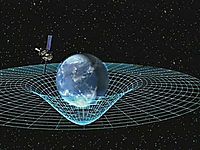
Photo from wikipedia
The Comment of M. Partanen and J. Tulkki [Phys. Rev. A {\bf 100}, 017801 (2019)] claims that my criticism expressed in Phys. Rev. A {\bf 98}, 043847 (2018) of the… Click to show full abstract
The Comment of M. Partanen and J. Tulkki [Phys. Rev. A {\bf 100}, 017801 (2019)] claims that my criticism expressed in Phys. Rev. A {\bf 98}, 043847 (2018) of the earlier paper of Partanen {\it et al.} [Phys. Rev. A {\bf 95}, 063850 (2017)] was incorrect. There are essentially three points involved here: (1) the first one regards the physical interpretation of the radiation pressure experiment of A. Kundu {\it et al.} [Sci. Rep. {\bf 7}, 42538 (2017)]. My mathematical analysis of this situation, although simple, was able to illustrate the main property of the experiment, namely that it showed the action from the radiation forces on the dielectric boundaries, and from the Lorentz force in the interior, but it had not any relationship to the Abraham-Minkowski momentum problem as was originally stated by the investigators. (2) The second point was my emphasis on the fact that in an electromagnetic pulse in a medium there cannot be an accompanying mechanical energy density of the same order of magnitude as the electromagnetic energy density itself. The electromagnetic wave carries with it a mechanical {\it momentum}, but not a mechanical {\it energy}. Here I illustrate this point by a simple numerical analysis. (3) When going to a relativistic formulation of the electromagnetic theory in matter, care must be taken to secure that fundamental conditions from field theory are satisfied. In particular, one cannot in general take the electromagnetic total energy and momentum of a radiation pulse to constitute a four-vector; such a property holds only if the electromagnetic energy-momentum tensor is divergence-free. For the Minkowski tensor this condition is satisfied, whereas for the Abraham tensor it is not.
Journal Title: Physical Review A
Year Published: 2019
Link to full text (if available)
Share on Social Media: Sign Up to like & get
recommendations!